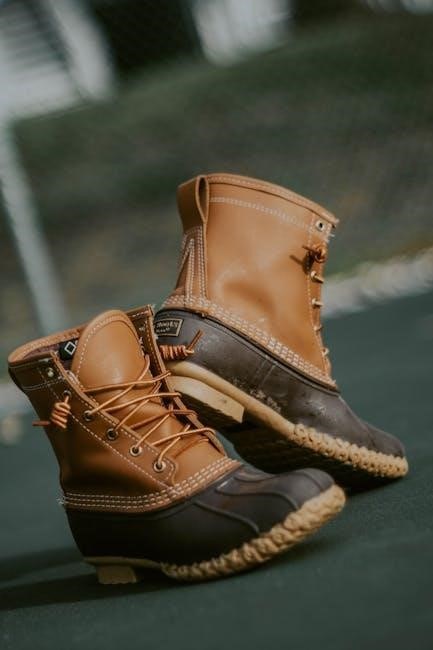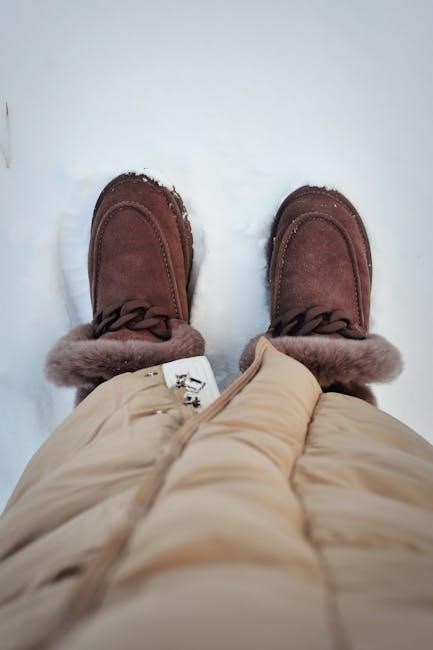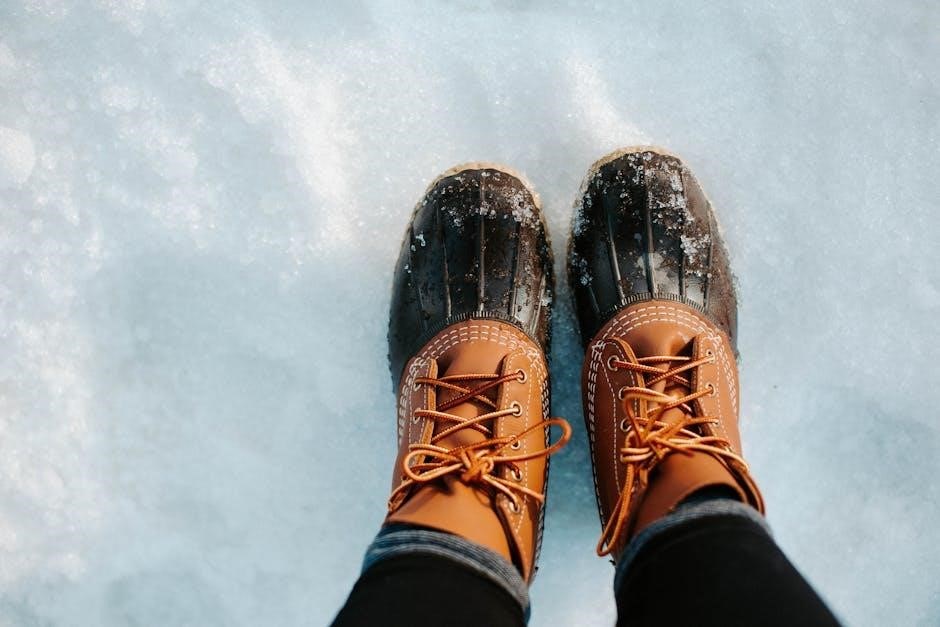Boot insulation is a crucial feature in footwear designed to keep feet warm and dry in cold conditions.
It involves using specific materials to trap heat and prevent moisture buildup, ensuring comfort during outdoor activities.
This guide explores the technology behind boot insulation, its importance, and how it enhances performance in various environments.
1.1 Why Boot Insulation is Important
Boot insulation is essential for maintaining foot warmth in cold environments, preventing heat loss, and reducing the risk of frostbite.
It ensures feet remain dry by repelling moisture, which is crucial for comfort and hygiene during outdoor activities.
Insulated boots improve circulation, reducing fatigue and enhancing overall performance in freezing conditions.
They are vital for individuals working or recreating outdoors, as cold feet can hinder productivity and safety.
Quality insulation also protects against harsh weather, making it a key feature for durability and long-term comfort in extreme temperatures.

Understanding the importance of boot insulation helps users make informed decisions for their specific needs and activities.

Understanding Boot Insulation
Boot insulation refers to the use of materials and technologies to retain warmth and protect feet in cold conditions, combining comfort with durability for various environments and activities.
2.1 How Boot Insulation Works
Boot insulation functions by trapping warm air close to the foot while preventing cold air and moisture from penetrating the boot.
Insulation materials, such as Thinsulate or similar technologies, are designed to reduce heat loss through conduction, convection, and radiation.
These materials have low thermal conductivity, meaning they resist the flow of heat, keeping feet warm even in freezing temperatures.
The insulation rating (e.g., 200g or 400g) indicates the amount of insulation, with higher ratings offering greater warmth for extreme cold conditions.
Moisture-wicking liners and waterproof membranes further enhance performance by keeping feet dry and preventing heat loss from wetness.
Overall, boot insulation creates a thermal barrier, ensuring comfort and protection in cold environments for extended periods.
2.2 Types of Insulation Materials
Boot insulation materials vary in type and performance, each offering unique benefits for different conditions.
Thinsulate™, developed by 3M, is a popular choice known for its lightweight, breathable, and moisture-wicking properties, providing warmth without bulk.
Down insulation uses natural down feathers, offering exceptional warmth but losing effectiveness when wet.
Synthetic insulation, such as Polarguard or Holofill, mimics down’s performance but retains warmth when wet, making it ideal for wet conditions.
Shearling or wool insulation is natural, breathable, and durable, though less common in modern boots.
Neoprene insulation is often used in waterproof boots, providing decent warmth and flexibility in cold, wet environments.
Understanding these materials helps users choose boots suited to their specific needs and activities.
2.3 Thinsulate Technology Explained
Thinsulate™ technology, developed by 3M, is a cutting-edge insulation solution designed for footwear and apparel.
It uses microfibers to create a lightweight, breathable barrier that traps warmth while allowing moisture to escape.
This technology is particularly effective in cold conditions, maintaining warmth even in damp environments.
Thinsulate™ is known for its versatility, offering different insulation levels, such as 200g and 400g, to suit various activities and temperatures.
Its unique construction prevents heat loss and ensures comfort, making it a preferred choice for insulated boots.
By combining durability and performance, Thinsulate™ enhances the overall functionality of boots in harsh weather conditions.

Boot Temperature Ratings
Boot temperature ratings indicate the footwear’s ability to keep feet warm in cold conditions, helping users choose appropriate boots for specific activities and weather.
3.1 What Do Temperature Ratings Mean?
Boot temperature ratings indicate the footwear’s ability to keep feet warm in cold conditions, helping users choose appropriate boots for specific activities and weather.
These ratings typically represent the lowest temperature at which the boots can maintain warmth, often measured in degrees Celsius or Fahrenheit.
They are determined by factors like insulation quality, boot construction, and moisture-wicking properties, ensuring comfort and protection in freezing environments.
Higher ratings generally mean better warmth, but actual performance may vary based on individual activity levels and environmental conditions.
Understanding these ratings is crucial for selecting boots that meet your needs, whether for casual winter walks or extreme outdoor adventures.
Choosing the Right Insulated Boots
Choosing the right insulated boots involves understanding your activity needs, weather conditions, and insulation levels. Proper fit and durability ensure optimal warmth and comfort while outdoors.
4.1 Factors to Consider When Selecting Boots
When selecting insulated boots, consider activity type, weather conditions, and personal comfort needs. Durability, waterproofing, and insulation ratings are key factors. Ensure a proper fit to avoid discomfort and blisters. Check for features like moisture-wicking linings and sturdy soles. Assess the environment—icy, snowy, or wet conditions may require specific traction or waterproofing. Budget and brand reputation also play a role. Understanding insulation levels, such as 200g vs 400g, helps match boots to temperature requirements. Additionally, consider the boot’s weight and flexibility for ease of movement. Prioritize features that align with your primary use, whether for hiking, work, or casual winter wear. Balancing these elements ensures optimal performance and comfort in cold weather.
4.2 Understanding Insulation Levels (200g vs 400g)

Insulation levels in boots, such as 200g and 400g, refer to the amount of insulation material used. Higher grams (e.g., 400g) mean more insulation, suitable for extreme cold. Lower levels (e.g., 200g) are lighter and breathable, ideal for milder conditions. The choice depends on activity level and temperature. For instance, 400g boots are better for stationary work in freezing temperatures, while 200g is suitable for active pursuits like hiking. Both options provide warmth but differ in weight and flexibility. Understanding these levels helps match boots to specific needs, ensuring comfort and performance in various environments. Always consider your activity type and expected temperatures when deciding between insulation levels. This ensures optimal warmth without sacrificing mobility or comfort.

Types of Insulated Boots
Insulated boots come in various styles, including hiking, work, winter, and casual boots, each designed for specific activities and weather conditions.
- Hiking boots for rugged trails.
- Work boots for job sites.
- Winter boots for extreme cold.
- Casual boots for everyday wear.
These types ensure warmth, durability, and comfort in diverse environments.
5.1 Boots for Different Activities and Conditions
Insulated boots are tailored to meet the demands of various activities and environments, ensuring optimal performance and comfort.
- Hiking Boots: Designed for rugged trails, these boots combine insulation with durability for cold, snowy, or icy terrains.
- Work Boots: Built for job sites, they offer insulation along with safety features like steel toes and slip-resistant outsoles.
- Winter Boots: Engineered for extreme cold, these boots often feature high insulation levels, waterproofing, and traction for snowy conditions.
- Casual Boots: Stylish and warm, these are perfect for everyday use in chilly weather, blending fashion with functionality.
Whether you’re hiking, working, or braving winter streets, there’s an insulated boot designed to match your needs and keep your feet warm and dry.

Care and Maintenance
Proper care extends the lifespan of insulated boots. Use waterproofing sprays, avoid harsh cleaners, and store in a dry, cool place to maintain insulation and quality.
6.1 Tips for Maintaining Insulated Boots
Regular maintenance is key to preserving the performance and longevity of insulated boots. Start by cleaning them with a soft brush or damp cloth to remove dirt and debris. Avoid using harsh chemicals or abrasive cleaners, as they can damage the materials. For waterproofing, apply a high-quality waterproofing spray or cream specifically designed for your boot material. Allow the boots to air dry naturally after exposure to moisture, avoiding direct heat sources that could degrade the insulation. Store your boots in a cool, dry place away from direct sunlight. Additionally, condition the leather periodically to maintain flexibility and prevent cracking. By following these care tips, you can ensure your insulated boots remain warm, waterproof, and comfortable for years to come.
Common Myths About Boot Insulation
Myths like “all insulated boots are bulky” or “insulation works only in extreme cold” are misleading. Proper insulation balances warmth, breathability, and mobility for optimal performance in various conditions.

7.1 Separating Fact from Fiction
When it comes to boot insulation, there are several misconceptions that can influence purchasing decisions. One common myth is that thicker insulation always means better warmth, but this isn’t true. While insulation like Thinsulate® offers excellent heat retention, it’s also lightweight and breathable, debunking the idea that insulated boots are bulky. Another myth is that insulation is only necessary for extreme cold, but moderate cold can also benefit from proper insulation to prevent discomfort. Additionally, some believe that all insulated boots are waterproof, but this depends on the materials and construction of the boot. Understanding these facts helps consumers make informed choices tailored to their needs and activities.